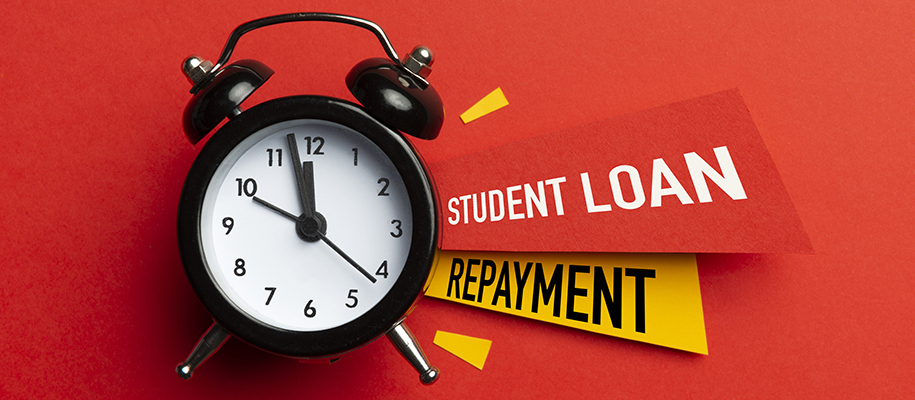Student loans have been a hot topic lately, thanks largely to President Biden’s recently announced loan forgiveness plan. The application allows eligible borrowers to apply for up to $20,000 in student loan forgiveness. The administration also extended the loan repayment pause through December 31, 2022. While it’s a welcome reprieve for many, borrowers with federal student loan debt exceeding the eligible cancellation amount must prepare for payments to resume in 2023. Ensuring you’re on the best repayment plan for your situation can help you maintain manageable loan payments moving forward. Let’s take a look at all your options so you can decide which plan is ideal for you.
Standard Repayment
The Standard Repayment Plan is available to borrowers with any federal student loan. This plan is typically used as the default repayment option for federal loans, spanning a 10-year repayment period. For Direct Consolidation Loan borrowers, the repayment period is 10–30 years. If you’re on a Standard Repayment Plan, your federal student loan is divided into 120 equal fixed monthly payments. It’s generally the shortest repayment option and results in the least amount of interest charges for borrowers.
- Standard is ideal for borrowers who want to save on interest and get out of student debt quickly. This plan allows borrowers who can afford the minimum payment during their entire loan term the benefit of paying off their loans faster.
- Standard is not ideal for borrowers who have high-figure debt, as the monthly payments might be too challenging to manage. It’s also not a viable option for borrowers pursuing loan forgiveness because the Standard Repayment Plan isn’t eligible.
Related: Types of Student Loans Explained: Federal vs. Private
Graduated Repayment
Borrowers on a Graduated Repayment Plan make monthly loan payments that start small but gradually increase every couple of years. The monthly payment and payment interval increases are calculated based on a 10-year repayment time frame. However, much like the Standard Plan, Direct Consolidation Loan borrowers might have a repayment period of 10–30 years. This repayment plan option is available to borrowers with a variety of federal loans, including subsidized and unsubsidized Direct Loans, subsidized and unsubsidized Stafford Loans, PLUS Loans, and Direct Consolidation Loans.
- Graduated is ideal for borrowers who need a lower monthly payment than what’s required under a Standard Plan but aren’t eligible for income-driven plans. This option is good if you have high student debt but aren’t a high earner right out of college and expect to earn more later in your career.
- Graduated is not ideal for borrowers who are pursuing loan forgiveness (the Graduated Plan is ineligible) or those who aren’t confident their earning levels will increase throughout the repayment term.
Extended Repayment
An extended repayment plan lets you prolong your repayment period to 25 years. Payment amounts can be fixed or graduated, based on your preference. The plan is available for Direct Loans, Stafford Loans, PLUS Loans, and Direct Consolidation Loans. Although it keeps your monthly payment amount below what you’d pay under a Standard Repayment Plan, you’ll pay more interest over time.
- Extended is ideal for borrowers who want to stretch their repayment terms and possibly keep a low monthly payment during the entire period. The Extended Plan is also an option if you don’t qualify for an income-driven plan and don’t anticipate needing loan forgiveness.
- Extended is not ideal for borrowers who plan on applying for loan forgiveness since it’s not a qualifying repayment plan. It’s also not ideal for borrowers who want to avoid paying more interest.
Related: Important Steps to Learn Smart Money Borrowing Practices for College
Revised Pay As You Earn
The Revised Pay As You Earn (REPAYE) Plan is one of four income-driven repayment plans available to certain federal loan borrowers. Under REPAYE, your monthly payment is based on 10% of your discretionary income. The calculation uses your family size and annual income as part of the payment calculation. You must recertify your income and family size annually—regardless of whether it’s changed. After 20 or 25 years of payments, any remaining Direct Loan balance is forgiven, and the forgiven amount is considered taxable income. If you’re married, your and your spouse’s incomes are both included in the payment calculation, regardless of how you file your taxes.
- REPAYE is ideal for borrowers who aren’t married. Since the plan always calculates payments based on both incomes of married spouses, being single will ensure you’re paying a fair amount for what you’re making. It’s also a good option for borrowers seeking loan forgiveness.
- REPAYE is not ideal for borrowers who anticipate an income spike during the repayment term. Unlike Pay As You Earn (PAYE), REPAYE doesn’t have a repayment cap, so as your income increases, your payment does too.
Income-Based Repayment
Under Income-Based Repayment (IBR), your monthly payments will be 10% or 15% of your discretionary income and paid over 20 or 25 years, depending on when you first borrowed your federal loans. Payments won’t exceed what you’d pay under a 10-year Standard Plan but are also determined by your family size and income. If you file your taxes jointly with a spouse, their income is included in your payment calculation. As with all other income-driven repayment plans, the remaining loan balance is forgiven after you’ve completed your term.
- IBR is ideal for borrowers who can demonstrate partial financial hardship, as this is a requirement and is advantageous for those pursuing loan forgiveness. It’s also great for borrowers with federally owned FFELP loans that haven’t been consolidated since it’s the only viable income-driven plan option otherwise.
- IBR is not ideal for borrowers who don’t meet the plan’s hardship requirements or have ineligible federal loans, like Parent PLUS Loans.
Related: 8 Ways to Pay Off Student Loans Faster and Save Money
Income-Contingent Repayment
Income-Contingent Repayment (ICR) is available to borrowers with any Direct Loan, including parents with a Parent PLUS Loan. It lets you make a payment at 20% of your discretionary income or the payment you’d make under a fixed payment plan over a 12-year period—whichever is less. Overall, the term duration is 25 years. Parent borrowers who’ve received a PLUS Loan on behalf of their student can qualify for this plan if they consolidate their loan into a Direct Consolidation Loan. If a remaining balance is left over after 25 years of qualifying payments, the amount is forgiven but taxed as income.
- ICR is ideal for borrowers who don’t otherwise qualify for other income-driven repayment plans. It’s also the only plan available to parent borrowers.
- ICR is not ideal for borrowers who expect their income to jump during their repayment period. Like REPAYE, this plan has no caps. If your income rises, your monthly payment can also increase—possibly higher than a 10-year Standard Plan.
Income-Sensitive Repayment
The Income-Sensitive Repayment Plan is exclusively designed for borrowers with loans through the Federal Family Education Loan (FFEL) Program, which is otherwise not eligible for an IDR Plan without consolidation. Monthly payment calculations differ between lenders but are based on your income. You can expect a repayment period of 15 years.
- ISR is ideal for low-income borrowers with non-consolidated FFEL Loans. This plan offers a straightforward repayment option for FFEL borrowers who need a low monthly payment but don’t meet eligibility requirements for other income-driven plans.
- ISR is not ideal for borrowers who expect a spike in their income during their repayment term since payments can increase or for those with ineligible Direct Loans.
Some final advice
For additional help, studentaid.gov offers a Loan Simulator tool that provides insight into plan eligibility, monthly payments, and your overall cost of borrowing. And if you’re pursuing the Public Service Loan Forgiveness (PSLF) Program, your options are a bit more restricted. That’s because PSLF participants are required to enroll in an income-driven repayment program to qualify.
Related: 5 Potential Downsides to Refinancing Your Student Loans
A major factor in choosing the right student loan repayment plan is understanding what your loans are eligible for. Once you rule out all ineligible programs, the few you’re left with will be easier to choose from based on your needs and expected income over time. Good luck with paying off your student loans!
Did you know there are scholarships and grants offered specifically to help with student loan payments? Use our Scholarship Search tool to find them!







